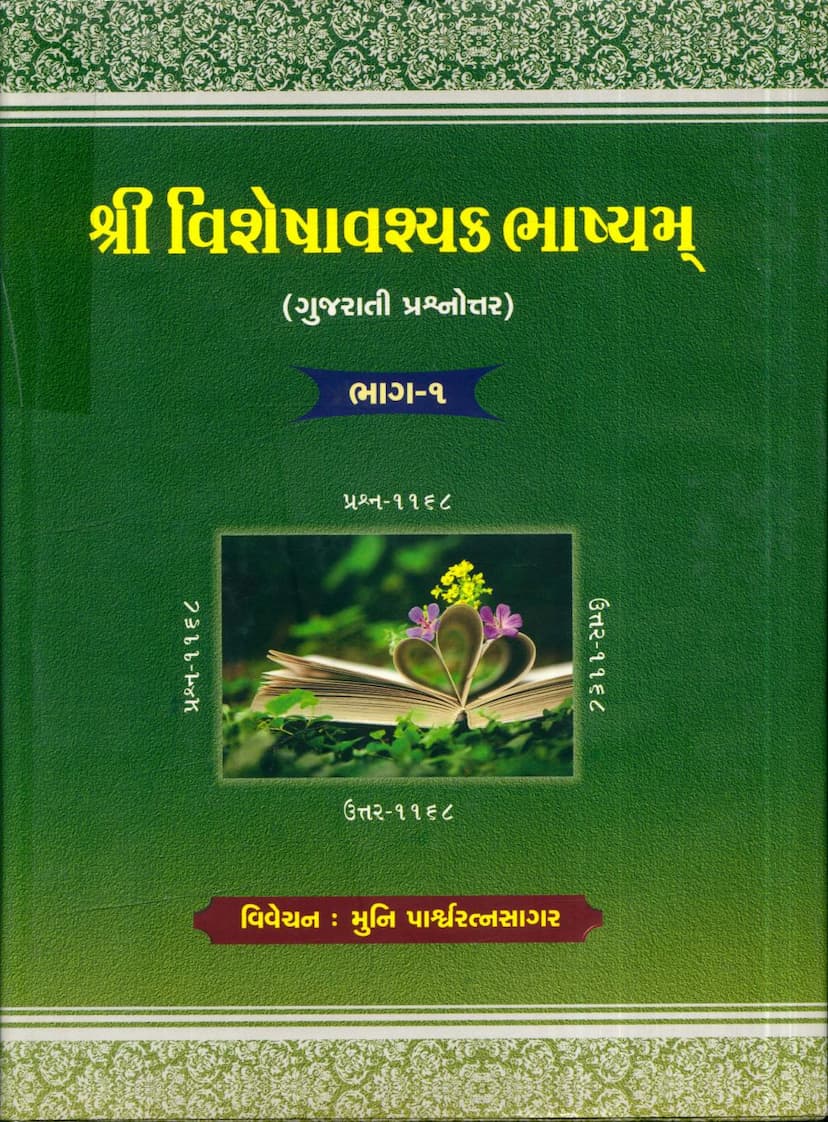Visheshavashyak Bhashya Part 01
Added to library: September 2, 2025

Summary
Here's a comprehensive summary of the provided Jain text, "Visheshavashyak Bhashya Part 01," based on the pages you've shared:
Book Title: Visheshavashyak Bhashyam (Gujarati Question-Answer) Part 01 Author/Commentator: Muni Parshwaratnasagar Publisher: Shri Chandraprabhu Jain Naya Mandir, Chennai Publication Year: V.S. 2071 (2014 CE) Catalog Link: https://jainqq.org/explore/023131/1
Overall Purpose and Context:
This book is presented as a Gujarati question-and-answer exposition of the "Visheshavashyak Bhashya," a significant Jain text. The commentary is provided by Muni Parshwaratnasagar. The publisher, Shri Chandraprabhu Jain Naya Mandir, has undertaken this publication as a service to the Jain community, aiming to make the complex teachings of the Visheshavashyak Bhashya accessible through a question-and-answer format.
Core Text: Visheshavashyak Bhashya
- Author of the Bhashya: Acharya Jinbhadra Ganeshramakshama-shraman.
- Subject: It's a commentary (Bhashya) on the Aavashyak Sutra, specifically focusing on the Samayik Adhyayan (chapter).
- Significance:
- It's described as a unique and profound text in Jain literature.
- It's considered an "all-encompassing" (Sarvanuyoga-mulak) text, meaning a thorough understanding of it prepares one for other Niyuktis and Angas.
- It logically and philosophically analyzes Jain doctrines and often compares them with viewpoints from other philosophical schools.
- It has greatly influenced later Jain scholars and logicians, with its arguments and reasoning being utilized in their works.
- It uses numerous small examples to explain complex concepts.
- It is considered a foundational text for establishing Jain terminology.
Commentary Literature (Vyakhyan Sahitya):
- Swopajna Teeka (Author's Own Commentary): Jinbhadra Ganeshramakshama-shraman wrote a brief but excellent commentary on the Bhashya. Unfortunately, it's incomplete, reaching up to Gatha 2318.
- Kotiyacharya's Teeka: Kotiyacharya completed the commentary where Jinbhadra Gani left off, following a similar concise style. His completion begins by acknowledging the incomplete work of Jinbhadra Gani.
- Maldhari Hemchandracharya's Teeka (Shishyashita Vrutti): This is a vast commentary, estimated to be around 28,000 shlokas, and is considered highly influential and widely studied today. It was completed in V.S. 1175. It's praised for its clarity and systematic presentation of philosophical and Agamaic discussions, often in a question-and-answer format. Hemchandracharya notes that he wrote this extensive commentary because the earlier ones were too terse for the intellects of his time.
- Kotiacharya's Vrutti: This is a separate commentary by Kotiacharya, approximately 13,700 shlokas long. The identity of this Kotiacharya is debated among scholars; some equate him with Shylanka, the commentator of Acharanga and Suyagdanga, while others believe they were distinct individuals from different centuries.
Commentator: Muni Parshwaratnasagar
- The book highlights Muni Parshwaratnasagar's diligence and scholarly efforts in creating this Gujarati question-and-answer version.
- His previous works include translations and commentaries on texts like Paumchariyam and Akhyanamanikosha.
- The publishers express deep appreciation for his work, which they believe will be very beneficial to the Jain community.
Key Themes and Content (as indicated by the initial questions and discussions):
- The Nature of Aavashyakas: The text begins by defining Aavashyakas as essential duties or practices that help one cross the ocean of Samsara (cycle of birth and death). They are described as collections of essential conduct (Charan), virtues (Guna), right knowledge (Gyan), and right faith (Darshan).
- Aavashyak as a Collection of Virtues: A significant discussion revolves around the idea that Aavashyaka, particularly Samayika, embodies the entirety of Charan and Guna, linking it to the broader Aavashyak Anuyoga.
- The Role of Gurus and Authority: The commentary emphasizes that their exposition is based on the teachings of Tirthankaras and Ganadharas, not their own independent intellect, acknowledging their limitations as 'Chhadmastha' (individuals with obscured knowledge). They highlight the necessity of following the Guru's instructions.
- Mangaala (Auspiciousness): The initial part of the text delves into the concept of auspiciousness, explaining its importance at the beginning, middle, and end of a text for the smooth completion of the work and its propagation through generations. It discusses the different types of auspiciousness: Nama (name), Sthapana (representation), Dravya (material), and Bhava (intentional).
- The Nature of Knowledge (Gyan): A substantial portion is dedicated to explaining the five types of knowledge in Jainism: Mati (sense-based perception), Shruta (scriptural knowledge), Avadhi (clairvoyance), Manahparyava (mind-reading), and Kevala (omniscience). Each is defined, and their characteristics and the distinctions between them are elaborated upon.
- Nayas (Standpoints): The text explores various Jain philosophical standpoints (Nayas) like Naigama, Vyavahara, Sangraha, Rujusutra, Shabda, Sambhirudha, Evambhuta, and Nischaya Naya. These are used to analyze concepts and resolve apparent contradictions.
- Detailed Analysis of Samayika Adhyayan: The subsequent questions and answers would delve into the specific details of the Samayika Adhyayan, covering its meaning, purpose, practices, and associated philosophical concepts as explained in the Visheshavashyak Bhashya and its commentaries.
Key Takeaways from the provided text:
- Scholarly Depth: The text is highly academic, providing in-depth analysis of Jain principles, logic, and terminology.
- Accessibility through Q&A: The question-and-answer format aims to clarify complex philosophical points for a Gujarati-speaking audience.
- Respect for Tradition: The commentary consistently refers back to the original scriptures (Aagamas) and the teachings of esteemed Acharyas, emphasizing the preservation of Jain knowledge.
- Comprehensive Coverage: The initial pages and the table of contents-like structure suggest a thorough exploration of the Visheshavashyak Bhashya, covering its philosophical underpinnings, historical context, and detailed explanations of concepts.
This summary is based solely on the provided text. The full scope of the book would involve the detailed exposition of each topic through the question-and-answer format initiated in the early pages.